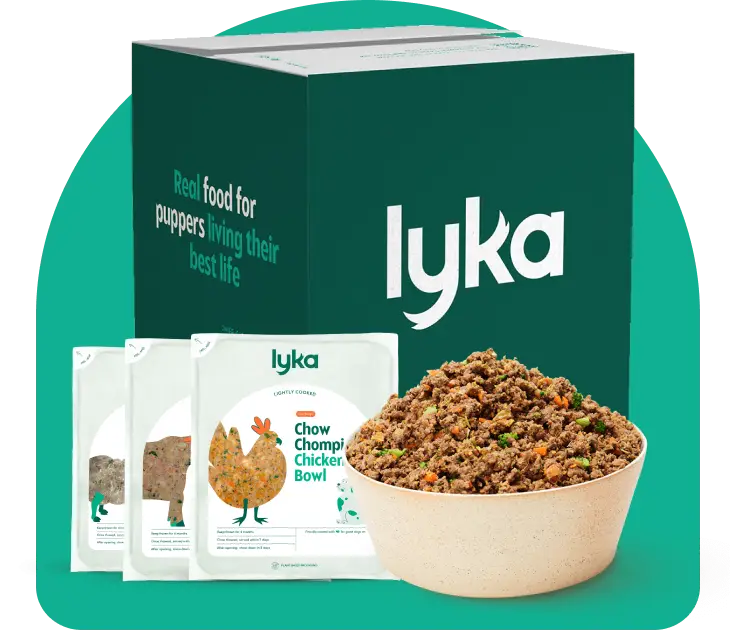If you’re weighing up key advantages and disadvantages of dry dog food versus fresh food for dogs, you’re not alone. Both can be convenient, but there’s a great deal of difference between the two when it comes to formulation, ingredients, and level of processing.
Dogs need a fresh and varied diet. The right balance of quality protein, healthy fats, vegetables, fruit, and superfoods can help dogs feel healthy and happy.
Every pup is unique. Their individual needs will depend on age, breed, size, weight, and health condition. Regardless of this, all dogs deserve real food.
Top takeaways
)
Nutrition and formulation: meeting ‘complete and balanced’ nutritional standards
In Australia, the pet food industry is unregulated: brands choose to meet international standards as a safer measurement of nutritional value. All dogs need a complete and balanced diet, containing essential nutrients in the right proportions.
The Association of American Feed Control Officials (AAFCO) and European Pet Food Industry Federation (FEDIAF) guidelines establish the minimum nutritional standards for complete and balanced pet food to sustain life.
In general, commercially produced dry food meets AAFCO and FEDIAF minimum standards for complete and balanced dog food. However, the lower quality of ingredients, and method of processing can compromise nutritional value.
Lyka’s stance on omega 6:3 ratios
Too much omega-6, and not enough omega-3 in your dog’s diet, can lead to inflammation. Lyka’s fresh food meals are formulated with high amounts of omega-3 fatty acids and antioxidants, which have proven anti-inflammatory benefits for dogs. Our food contains the optimal omega 6:3 ratio of 2-3.6:1 — this is much lower than AAFCO’s recommended ratio of 30:1, which kibble companies follow.
Dry dog food can contain an excess of pro-inflammatory omega-6s, which research has linked to inflammation. Inflammation plays a key role in the severity of chronic health issues in dogs.
For Lyka’s team of board-certified veterinary nutritionists, meeting AAFCO and FEDIAF guidelines is just the start. Lyka contains high-quality, human-grade ingredients: gently cooked to retain nutritional value and digestibility. Our fresh meals are formulated with moderate to high amounts of protein, and minimal amounts of low-glycaemic carbohydrates to avoid blood sugar spikes.
Nutritional breakdown (dry matter)
)
Finding the best food for different life stages and health concerns
Lyka meals contain abundant nutrients suitable for all life stages: from puppy to golden oldie and every phase in between. All dogs benefit from a nutrient-rich diet, and it's never too late to make a change to your pup’s health status via nutrition.
Limiting inflammation is essential for puppies, seniors, and dogs with conditions affecting the gut, skin, joints, and mind.
Diets like kibble also contain moderate to high amounts of pro-inflammatory carbohydrates and omega-6s. With a fresh diet such as Lyka, your dog gets high yet safe amounts of Vitamin E, D, C, and zinc to support wellbeing, and none of our meals contain preservatives, colours, or flavour enhancers.
Ingredient quality
Optimal dog food relies on high-quality ingredients that maintain their nutritional integrity.
Lyka source superior produce with bioavailable nutrients that are more effectively absorbed into your dog’s body, boosting their health and wellbeing.
The quality of ingredients used in dry dog food depends on the brand. Many use pet-grade animal protein from unverified sources: these are labelled as meat meals or meat by-products. Meat meals are usually by-products from slaughterhouses and can include bones, offal, blood, and carcasses.
Lyka only uses human-grade* meat sourced as ethically and sustainably as possible, like our free-range chicken. We choose healthier proteins like grass-fed beef because it’s higher in omega-3 (anti-inflammatory) and lower in omega-6 (pro-inflammatory), compared to grain-fed beef.
Each Lyka meal is made from 85-95% Australian ingredients, including the animal proteins. We use fresh “ugly bunch” fruit and vegetables — this is produce deemed too ugly for supermarkets, but is still delicious and packed with phytonutrients that aren’t lost due to processing.
Our food has high yet safe amounts of Vitamin E, D, C, and zinc to support your pup’s health, and none of our meals contain preservatives, colours, or flavour enhancers.
Highly processed dry food is often low in protein with moderate to high amounts of carbohydrates like potatoes, grains, and rice. Dog food with a high glycaemic load may lead to health concerns like weight gain, blood-glucose spikes, or pancreas problems.
Other common carbohydrates used in processed food include cereal grains like wheat, barley, and rice that can trigger allergic flare ups: a response causing inflammation and itchy skin. The cereal content also increases the risk of mycotoxins that can lead to serious disease.
* Human grade means it’s fit for human consumption — a process that’s strictly regulated in Australia.
Cooking and processing
Lyka is considered minimally processed dog food, while dry food is highly processed.
To create Lyka food, ingredients are diced, mixed, and steamed at a low temperature (between 75-90°C) for a short duration. The food is cooled down safely, packaged into portions, then snap frozen.
This process supports nutrient integrity, preventing the need for preservatives and enhancing the natural flavours of each meal. Gently cooking the food reduces risk of pathogens by a significant amount, and is easier for sensitive tummies to digest in comparison to kibble.
Dry dog food ingredients are ground into a fine texture and mixed with starchy vegetables, additives, stabilisers, and preservatives. The mixture is cooked at temperatures between 100°C and 120°C, to kill bacteria and moisture.
The final step is called extrusion — this is the point at which kibble pellets are formed. Extrusion involves high temperatures (ranging from 120°C to over 180°C), where the mixture is pushed through the extruder with significant mechanical force.
High heat used during processing can lead to the potential formation of compounds that are harmful to both humans and animals alike: these include Acrylamides, Heterocyclic Amines, and Advanced Glycation End Products (AGEs).
“Some essential vitamins and minerals are degraded during these harsh processing steps. Synthetic nutrients need to be added back in as a replacement — but these don’t fully replicate the natural nutrients found in wholefoods in terms of bioavailability.”
— Dr Matthew Muir, Lyka Co-founder and Integrative Veterinarian
Variety and taste
Food variety supports a diverse and balanced microbiome — vital to the health of your dog’s immune system, digestion, and brain function. Fresh food diets typically offer more variety than kibble, and gut diversity has a strong bearing on overall health, via the gut-brain axis. A varied diet can also alleviate problems with fussiness.
A rotation of fresh ingredients will delight your dog’s tastebuds, increasing their enjoyment at mealtimes and boosting your special bond. Lyka has a range of 6 proteins to choose from: Beef, Lamb, Chicken, Turkey and Kangaroo. That’s one for nearly every day of the week! Each meal contains limited protein: a single protein base (like beef) with fish oil or sardines for an omega-3 boost.
While the shelf stability of kibble might be appealing, feeding your dog the same meal every day may reduce the diversity of good gut bacteria. The benefits of food quality and variety reduce when the ingredients have undergone high processing that has stripped the ingredients of their natural textures and nutrients. For this reason, it’s common to find the use of added flavours, salt, and sugar in dry food to make it palatable for dogs to eat.
Transparency
Understanding dog food labels is important when navigating the world of dog food.
For example, if a certain meat ingredient (like beef) makes up 25% or more of all meats included, kibble brands can label the product as “Beef Dry Food”. Dry food labelled as ‘with chicken’ (or any other protein) only need to contain a minimum of 3% of that ingredient.
If you’re considering Lyka, check out our list of purposeful ingredients and find out why we think their origins and benefits are suitable for your dog — or get in touch with our friendly Customer Care specialists for more information.
Knowing exactly what ingredients are in each meal gives you the power to shape your dog’s meal plans to suit their specific health needs or preferences.
Lyka: going above and beyond for all dogs
A simple shift in what you put in your dog’s bowl can have a life-changing impact on their health.
Lyka dog food is formulated by board-certified veterinary nutritionists to go above and beyond nutritional standards for all dogs at all life stages, from puppy to senior and everything in between. Each gently cooked meal is made from high-quality, locally sourced ingredients, making them a nourishing option for dogs.
Choosing the right food can be overwhelming — we’re here to keep things simple, and make sure you’ve got all the information you need to make the best decision.
Is your pup ready to feel the difference?
)
)
)
)
)
)
)
)

)
)
)
)
)
